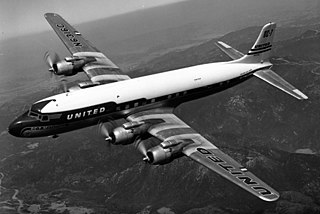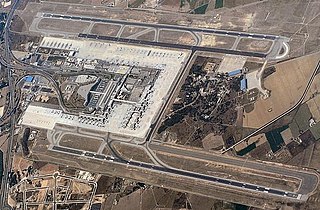Iberia, legally incorporated as Iberia Líneas Aéreas de España, S.A. Operadora, Sociedad Unipersonal, is the flag carrier airline of Spain. Founded in 1927 and based in Madrid, it operates an international network of services from its main base of Madrid–Barajas Airport. Iberia, with Iberia Regional and with Iberia Express, is a part of International Airlines Group. In addition to transporting passengers and freight, Iberia Group carries out related activities, such as aircraft maintenance, handling in airports, IT systems and in-flight catering. Iberia Group airlines fly to over 109 destinations in 39 countries, and a further 90 destinations through code-sharing agreements with other airlines.
The Societé anonyme belge d'Exploitation de la Navigation aérienne, better known by the acronym Sabena or SABENA, was the national airline of Belgium from 1923 to 2001, with its base at Brussels National Airport. After its bankruptcy in 2001, SN Brussels Airlines was formed through a takeover of former subsidiary Delta Air Transport and took over part of Sabena's assets in February 2002, which became Brussels Airlines after a merger with Virgin Express in March 2007. The airline's corporate headquarters were located in the Sabena House on the grounds of Brussels Airport in Zaventem.

The Convair 880 is an American narrow-body jet airliner produced by the Convair division of General Dynamics. It was designed to compete with the Boeing 707 and Douglas DC-8 by being smaller but faster, a niche that failed to create demand. When it was first introduced, some in aviation circles claimed that at 615 mph (990 km/h), it was the fastest jet transport in the world. Only 65 Convair 880s were produced over the lifetime of the production run from 1959 to 1962, and General Dynamics eventually withdrew from the airliner market after considering the 880 project a failure. The Convair 990 Coronado was a stretched and faster variant of the 880.

The Convair 990 Coronado is an American narrow-body four-engined jet airliner produced between 1961 and 1963 by the Convair division of American company General Dynamics. It was a stretched version of its earlier Convair 880 produced in response to a request from American Airlines: the 990 was lengthened by 10 ft (3.0 m), which increased the number of passengers from between 88 and 110 in the 880 to between 96 and 121. This was still fewer passengers than the contemporary Boeing 707 or Douglas DC-8, although the 990 was 25–35 mph (40–56 km/h) faster than either in cruise.

The Douglas DC-7 is an American transport aircraft built by the Douglas Aircraft Company from 1953 to 1958. A derivative of the DC-6, it was the last major piston engine-powered transport made by Douglas, being developed shortly after the earliest jet airliner—the de Havilland Comet—entered service and only a few years before the jet-powered Douglas DC-8 first flew in 1958. Unlike other aircraft in Douglas's line of propeller-driven aircraft, no examples remain in service in the present day, as compared to the far more successful DC-3 and DC-6.
This is a list of aviation-related events from 1973:
Aviateca S.A. branded Avianca Guatemala is a regional airline headquartered in Guatemala City. Aviateca was under government ownership and remained so until 1989 when it joined the Grupo TACA alliance of Central America and was privatized. It was fully integrated into TACA, operating under the TACA Regional banner, which later merged with Avianca.
Aero California was a low-cost airline with its headquarters in La Paz, Baja California Sur, Mexico, operating a network of domestic passenger flights with its hub at the city's Manuel Márquez de León International Airport.

Tenerife North–Ciudad de La Laguna Airport, formerly Los Rodeos Airport, is the smaller of the two international airports on the island of Tenerife, Spain. It is located in San Cristóbal de La Laguna, 11 km (7 mi) by road from Santa Cruz and at an elevation of 633 metres (2,077 ft). It handled 3,717,944 passengers in 2012. Combined with Tenerife South Airport, the island gathers the highest passenger movement of all the Canary Islands, with 12,248,673 passengers, surpassing Gran Canaria Airport. Today TFN is an inter-island hub connecting all seven of the main Canary Islands with connections to the Iberian Peninsula and Europe.

RUTACA Airlines is an airline headquartered in Ciudad Bolívar, Venezuela with its home base at Tomás de Heres Airport and a hub at Simón Bolívar International Airport in Caracas.

The McDonnell Douglas DC-9 is an American five-abreast, single-aisle aircraft designed by the Douglas Aircraft Company. It was initially produced by the developer company as the Douglas DC-9 until August 1967 and then by McDonnell Douglas. After introducing its heavy DC-8 in 1959, Douglas approved the smaller, all-new DC-9 for shorter flights on April 8, 1963. The DC-9-10 first flew on February 25, 1965, and gained its type certificate on November 23, to enter service with Delta Air Lines on December 8. The aircraft has two rear-mounted Pratt & Whitney JT8D low-bypass turbofans under a T-tail for a cleaner wing aerodynamic, a two-person flight deck, and built-in airstairs.

Aviación y Comercio, S.A., doing business as Aviaco, was a Spanish airline headquartered in the Edificio Minister in Madrid.
Iberia Líneas Aéreas de España, S.A., usually shortened to Iberia, is the largest airline of Spain, based in Madrid.

Karair was an airline from Finland. Initially having offered scheduled passenger flights, the company became a subsidiary of Finnair, mainly operating on holiday charter routes.

Palma de Mallorca Airport is an international airport located 8 km (5.0 mi) east of Palma, Mallorca, Spain, adjacent to the village of Can Pastilla. In 2020, the airport handled 6.1 million passengers, making it the third busiest airport in Spain, after Madrid–Barajas and Barcelona-El Prat. The airport is the main base for the Spanish carrier Air Europa and also a focus airport for Eurowings, EasyJet, Jet2.com, Ryanair and Vueling. The airport shares runways with the nearby Son Sant Joan Air Force Base, operated by the Spanish Air and Space Force.

The 1973 Nantes mid-air collision occurred when two airliners travelling to London Heathrow airport hit each other over Nantes, France, on 5 March 1973. They were an Iberia McDonnell Douglas DC-9 flying from Palma de Mallorca to London and a Spantax Convair 990 from Madrid to London. All 68 people on board the DC-9 were killed. The CV-990 was able to make a successful emergency landing at Cognac – Châteaubernard Air Base.

Spantax Flight 275, registration number EC-BZR, was a Convair 990 Coronado charter flight operated by Spantax from Tenerife to Munich with 148 passengers and 7 crew. On December 3, 1972, the plane crashed while taking off from Tenerife-Norte Los Rodeos Airport in Tenerife, killing everyone aboard. Many of the passengers were West German tourists heading home.













